
Dame Edith Louisa Sitwell was a British poet and critic and the eldest of the three literary Sitwells. She reacted badly to her eccentric, unloving parents and lived much of her life with her governess. She never married but became passionately attached to Russian painter Pavel Tchelitchew, and her home was always open to London's poetic circle, to whom she was generous and helpful.
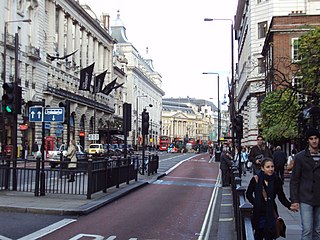
Piccadilly is a road in the City of Westminster, London, England, to the south of Mayfair, between Hyde Park Corner in the west and Piccadilly Circus in the east. It is part of the A4 road that connects central London to Hammersmith, Earl's Court, Heathrow Airport and the M4 motorway westward. St James's is to the south of the eastern section, while the western section is built up only on the northern side. Piccadilly is just under 1 mile (1.6 km) in length, and it is one of the widest and straightest streets in central London.

Pall Mall is a street in the St James's area of the City of Westminster, Central London. It connects St James's Street to Trafalgar Square and is a section of the regional A4 road. The street's name is derived from pall-mall, a ball game played there during the 17th century, which in turn is derived from the Italian pallamaglio, literally "ball-mallet".

The Carlton Club is a private members' club in St James's, London. It was the original home of the Conservative Party before the creation of Conservative Central Office. Membership of the club is by nomination and election only.

St James's is a central district in the City of Westminster, London, forming part of the West End. The area was once part of the northwestern gardens and parks of St. James's Palace. During the Restoration in the 17th century, the area was developed as a residential location for the British aristocracy, and around the 19th century was the focus of the development of their gentlemen's clubs. Once part of the parish of St Martin in the Fields, much of it formed the parish of St James from 1685 to 1922. Since the Second World War the area has transitioned from residential to commercial use.

James Harris, 1st Earl of Malmesbury, was an English diplomat.
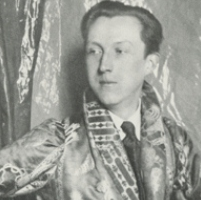
Sir Sacheverell Reresby Sitwell, 6th Baronet, was an English writer, particularly on baroque architecture, and an art and music critic. Dame Edith Sitwell and Sir Osbert Sitwell were his older siblings.

Sir Francis Osbert Sacheverell Sitwell, 5th Baronet CH CBE was an English writer. His elder sister was Edith Sitwell and his younger brother was Sacheverell Sitwell. Like them, he devoted his life to art and literature.
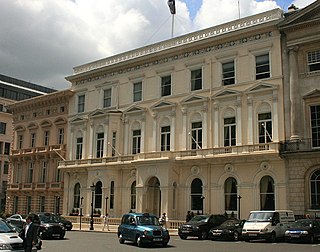
The East India Club is a gentlemen's club founded in 1849 and situated at 16, St James's Square in London. The full title of the club is East India, Devonshire, Sports and Public Schools' Club due to mergers with other clubs. The club was originally founded for officers of the East India Company, and its first Patron was Prince Albert.
West Kensington, formerly North End, is an area in the ancient parish of Fulham, in the London Borough of Hammersmith and Fulham, England, 3.4 miles (5.5 km) west of Charing Cross. It covers most of the London postal area of W14, including the area around Barons Court tube station, and is defined as the area between Lillie Road and Hammersmith Road to the west, Fulham Palace Road to the south, Hammersmith to the north and West Brompton and Earl's Court to the east. The area is bisected by the major London artery the A4, locally known as the Talgarth Road. Its main local thoroughfare is the North End Road.
The United University Club was a London gentlemen's club, founded in 1821. It occupied the purpose-built University Club House, at 1, Suffolk Street, London, England, from 1826 until 1971.

Sir George Reresby Sitwell, 4th Baronet was a British antiquarian writer and Conservative politician who sat in the House of Commons between 1885 and 1895.
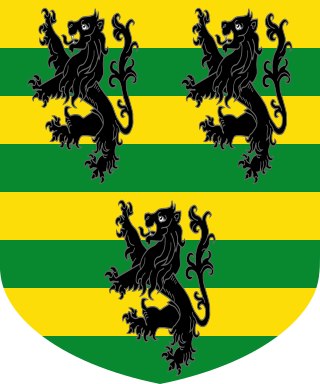
The Sitwell Baronetcy, of Renishaw in the County of Derby, is a title in the Baronetage of the United Kingdom. It was created on 3 October 1808 for Sitwell Sitwell, Member of Parliament for West Looe. The Sitwell family had been ironmasters and landowners in Eckington, Derbyshire, for many centuries.
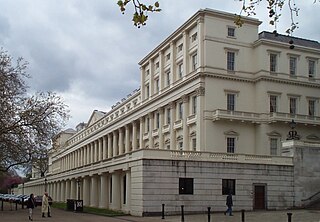
The Turf Club is a London gentlemen's club, established in 1861 as the Arlington Club. It has been located at 5, Carlton House Terrace since 1965.
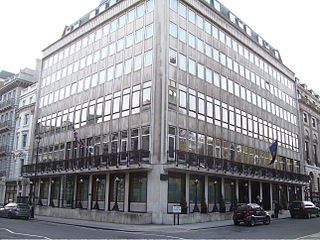
The Army and Navy Club in London is a private members club founded in 1837, also known informally as The Rag.

The Oriental Club in London is an exclusive Private Members’ Club established in 1824. Charles Graves describes it as fine in quality as White's but with the space of infinitely larger clubs. It is located in Stratford Place, near Oxford Street and Bond Street.
The Eccentric Club is the name of several London gentlemen's clubs, the best-known of which existed between 1890 and 1986. For much of its history it was based at 9–11 Ryder Street, St James's. The current Club was founded in 2008.
Rubeigh James Minney was a British film producer, journalist, playwright, editor and author. He was author of over 40 books including novels and biographies. As a film-maker and film producer, he worked with British film companies such as Gainsborough Pictures, and was invited to Hollywood by Darryl F. Zanuck. He was also a journalist in India and London, and editor of several newspapers.
Left Hand, Right Hand! is an autobiography in five volumes by the English poet and man of letters Osbert Sitwell. It relates in opulent detail the story of the author's early life in relation to his ancestors, his immediate family, especially his father Sir George Sitwell, and the fashionable and artistic world of his time. The five volumes are: Left Hand, Right Hand! (1944), re-titled in some editions The Cruel Month, about his ancestry and early childhood; The Scarlet Tree (1945), about his education at Eton and his first experiences of Italy; Great Morning (1947), about his boyhood and his peacetime service as an army officer; Laughter in the Next Room (1948), about his career after the First World War as a writer; and Noble Essences (1950), about his many notable friends. A sixth volume, Tales My Father Taught Me (1962), which was not formally included in the sequence, relates a number of further anecdotes about Sir George. Left Hand, Right Hand! has been acclaimed by both critics and readers from its first publication up to the present century, and is widely recognized as Sitwell's greatest work.














